Содержание
- 2. Introduction The paper presents the early published and the new results of investigation of the hydrogen
- 3. Outline 1. The experimental devices and methods 2. The hydrogen and oxygen trapping and retention in
- 4. The experimental devices and methods
- 5. Thermal Desorptional Stand (TDS-2) 1 - heated cathode, 2 - sample heater, 3 - sample, 4
- 6. Multipurpose Plasma Irradiation and Thermodesorption Device (MIKMA) 1 - Lock chamber, 2 - Ion gun chamber,
- 7. Experimental parameters Тhe residual gas pressure is about 1×10-3 Pa in TDS-2 and about 1×10-4 Pa
- 8. Hydrogen and oxygen trapping and retention in CFC and PG
- 9. Energy dependence of deuterium trapping in PG and CFC irradiated by the plasma ions and electrons
- 10. Flux (time) dependence of deuterium trapping in CFC ji = 1020 at/m2s, Φi = 5×1023 at/m2s
- 11. TDS spectra of D2 desorbed from CFC irradiated by electrons and deuterium ions. 1. The “potential”
- 12. TDS spectra of D2 desorbed from PG irradiated by electrons and deuterium ions. ji = 1020
- 13. Спектры десорбции водорода из графита МПГ-8 облученного ионами различных энергий и электронами TDS spectra of H2
- 14. Temperature dependence of deuterium trapping in CFC Amount of retained deuterium drops with increase of irradiation
- 15. Deuteromethane formation in CFC irradiated by deuterium ions and electrons Thermal desorption of deuterium as CD4
- 16. TDS spectra of deuterium as D2 and CD4 from CFC irradiated by deuterium ions and electrons
- 17. Deuterium trapping in CFC exposed in deuterium plasma with oxygen impurities Deuterium and CO desorption in
- 18. The hydrogen and oxygen trapping and retention in SS and nickel
- 19. Modification of working gas composition during plasma discharge Irradiation of the walls of the SS vacuum
- 20. The possible D-atom/ion induced exothermic reactions on the SS surface resulting in the “waters” molecule formation
- 21. The deuterium, hydrogen and oxygen trapping in the annealed SS (Pw.g = (1.4-1.5)×10-1 Pa, Exposition =40
- 22. Energy dependence on deuterium trapping in SS and nickel irradiated by the plasma ions Under low
- 23. Fluence dependence on deuterium and oxygen trapping in SS and nickel Irradiation dose, х 1022 ат/м2
- 24. Conclusion Carbon materials. CFC and PG trap deuterium even when the energy of impinging plasma particles
- 25. Conclusion SS and Nickel. Irradiation of the walls of the SS vessel with the neutrals or/and
- 27. Скачать презентацию
Слайд 2Introduction
The paper presents the early published and the new results of investigation
Introduction
The paper presents the early published and the new results of investigation
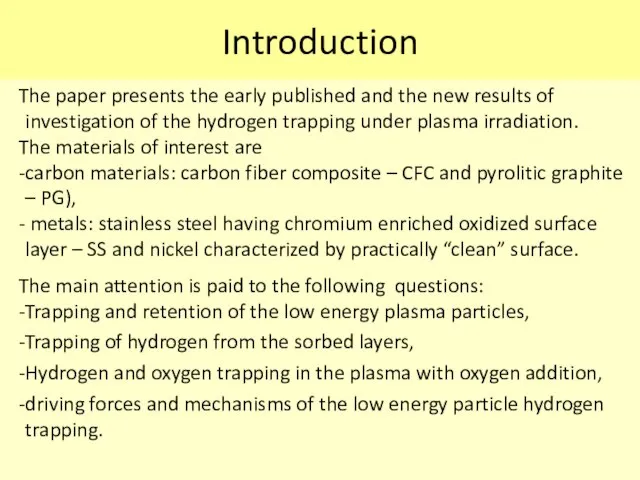
The materials of interest are
carbon materials: carbon fiber composite – CFC and pyrolitic graphite – PG),
metals: stainless steel having chromium enriched oxidized surface layer – SS and nickel characterized by practically “clean” surface.
The main attention is paid to the following questions:
Trapping and retention of the low energy plasma particles,
Trapping of hydrogen from the sorbed layers,
Hydrogen and oxygen trapping in the plasma with oxygen addition,
driving forces and mechanisms of the low energy particle hydrogen trapping.
Слайд 3Outline
1. The experimental devices and methods
2. The hydrogen and oxygen trapping and
Outline
1. The experimental devices and methods
2. The hydrogen and oxygen trapping and

energy dependence and trapping mechanism,
flux (time) dependence,
temperature dependence,
hydrogen and oxygen trapping under irradiation in D2+O2 plasma,
CD4 formation and desorption.
3. The hydrogen and oxygen trapping and retention in SS and nickel
- modification of working gas composition during plasma discharge,
- energy dependence of trapping,
- fluence dependence of trapping.
4. Conclusion
Слайд 4The experimental devices and methods
The experimental devices and methods

Слайд 5Thermal Desorptional Stand (TDS-2)
1 - heated cathode,
2 - sample heater,
3 -
Thermal Desorptional Stand (TDS-2)
1 - heated cathode,
2 - sample heater,
3 -
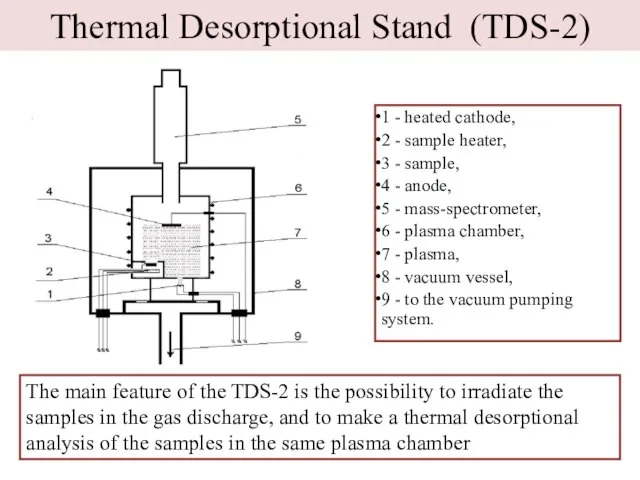
4 - anode,
5 - mass-spectrometer,
6 - plasma chamber,
7 - plasma,
8 - vacuum vessel,
9 - to the vacuum pumping system.
The main feature of the TDS-2 is the possibility to irradiate the samples in the gas discharge, and to make a thermal desorptional analysis of the samples in the same plasma chamber
Слайд 6Multipurpose Plasma Irradiation and Thermodesorption Device (MIKMA)
1 - Lock chamber, 2 -
Multipurpose Plasma Irradiation and Thermodesorption Device (MIKMA)
1 - Lock chamber, 2 -
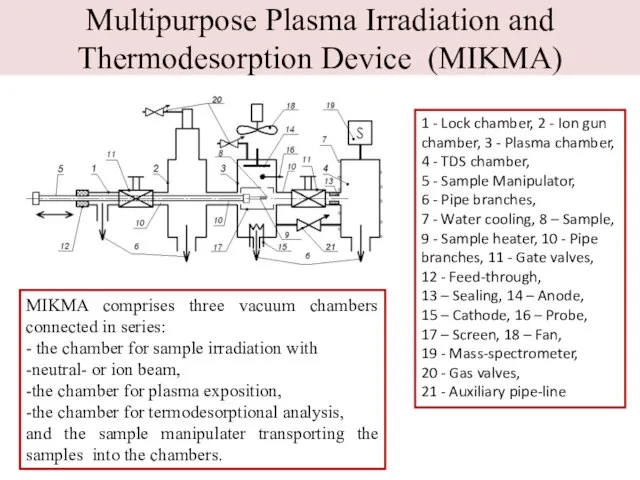
4 - TDS chamber,
5 - Sample Manipulator,
6 - Pipe branches,
7 - Water cooling, 8 – Sample,
9 - Sample heater, 10 - Pipe branches, 11 - Gate valves,
12 - Feed-through,
13 – Sealing, 14 – Anode,
15 – Cathode, 16 – Probe,
17 – Screen, 18 – Fan,
19 - Mass-spectrometer,
20 - Gas valves,
21 - Auxiliary pipe-line
MIKMA comprises three vacuum chambers connected in series:
- the chamber for sample irradiation with
-neutral- or ion beam,
-the chamber for plasma exposition,
-the chamber for termodesorptional analysis,
and the sample manipulater transporting the samples into the chambers.
Слайд 7Experimental parameters
Тhe residual gas pressure is about 1×10-3 Pa in TDS-2 and
Experimental parameters
Тhe residual gas pressure is about 1×10-3 Pa in TDS-2 and

The working gas (D2) pressure is about (1.4-1.5)×10-1 Pa in both devices.
The plasma composition is the D2 ions (82–85%), and the remaining part is D1 and D3 ions.
The samples are 1) CFC N11, 2) pyrolytic graphite PG99, MPG-8 graphite 3) nickel, 4) stainless steel 12Х18Н10Т (0.12%C, 18%Cr, 10%Ni, ≤1%Ti)
The CFC and PG samples are annealed at 1800 K and the metal samples at 1450 K.
The PG samples were irradiated perpendicular to hexagonal layers.
The samples were irradiated in the plasma and the gases retained in the samples during irradiation were measured by thermal desorptional spectrometry (TDS).
Mass-spectrometers were calibrated with the help of the calibrated leakage. The sample heating rate during TDS was equal to 5 K/s.
Слайд 8Hydrogen and oxygen trapping and retention in CFC and PG
Hydrogen and oxygen trapping and retention in CFC and PG
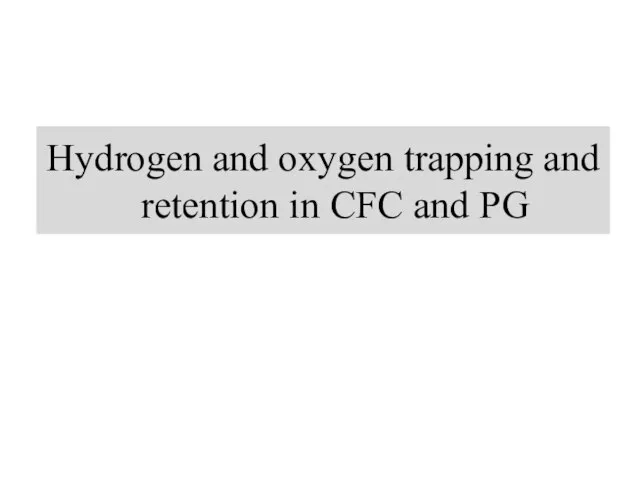
Слайд 9Energy dependence of deuterium trapping in PG and CFC irradiated by the
Energy dependence of deuterium trapping in PG and CFC irradiated by the
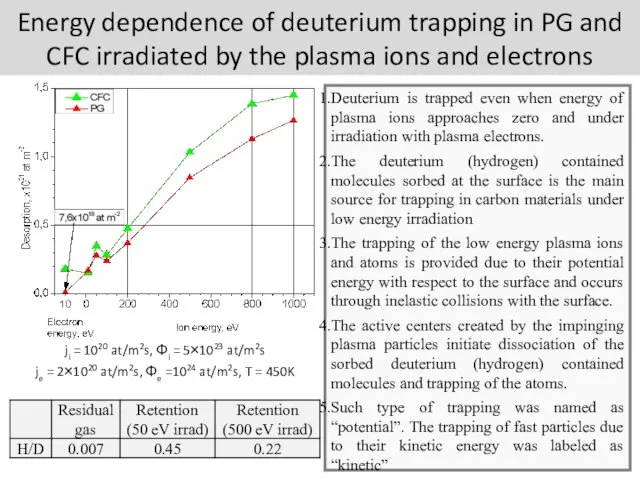
ji = 1020 at/m2s, Φi = 5×1023 at/m2s
je = 2×1020 at/m2s, Φe =1024 at/m2s, T = 450K
Deuterium is trapped even when energy of plasma ions approaches zero and under irradiation with plasma electrons.
The deuterium (hydrogen) contained molecules sorbed at the surface is the main source for trapping in carbon materials under low energy irradiation
The trapping of the low energy plasma ions and atoms is provided due to their potential energy with respect to the surface and occurs through inelastic collisions with the surface.
The active centers created by the impinging plasma particles initiate dissociation of the sorbed deuterium (hydrogen) contained molecules and trapping of the atoms.
Such type of trapping was named as “potential”. The trapping of fast particles due to their kinetic energy was labeled as “kinetic”
Слайд 10Flux (time) dependence of deuterium trapping in CFC
ji = 1020 at/m2s,
Flux (time) dependence of deuterium trapping in CFC
ji = 1020 at/m2s,
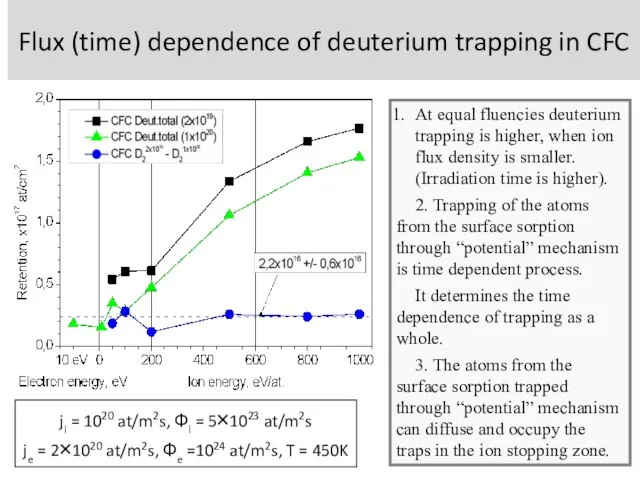
je = 2×1020 at/m2s, Φe =1024 at/m2s, T = 450K
At equal fluencies deuterium trapping is higher, when ion flux density is smaller. (Irradiation time is higher).
2. Trapping of the atoms from the surface sorption through “potential” mechanism is time dependent process.
It determines the time dependence of trapping as a whole.
3. The atoms from the surface sorption trapped through “potential” mechanism can diffuse and occupy the traps in the ion stopping zone.
Слайд 11TDS spectra of D2 desorbed from CFC irradiated by electrons and deuterium
TDS spectra of D2 desorbed from CFC irradiated by electrons and deuterium

1. The “potential” traps formed under low energy ion- and electron irradiation are similar and differ from the “kinetic” traps created under high energy (Ei >100-200 eV) ion irradiation.
2. “Kinetic” traps are created
with ions having energy
3. In both cases some fraction of deuterium atoms penetrates behind the region directly influenced by ions and are trapped there.
4. The defects formed in the stopping zone diffuse out of it and promote the deuterium diffusion into the bulk
ji = 1020 at/m2s, Φi = 5×1023 at/m2s
je = 2×1020 at/m2s, Φe =1024 at/m2s, T = 450K
Слайд 12TDS spectra of D2 desorbed from PG irradiated by electrons and deuterium
TDS spectra of D2 desorbed from PG irradiated by electrons and deuterium
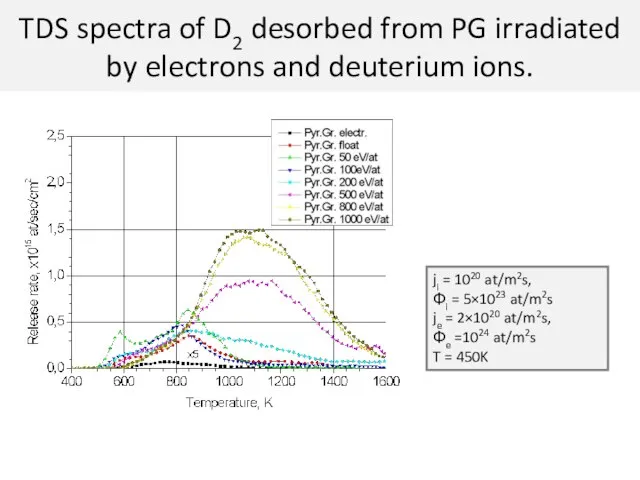
ji = 1020 at/m2s,
Φi = 5×1023 at/m2s
je = 2×1020 at/m2s,
Φe =1024 at/m2s
T = 450K
Слайд 13Спектры десорбции водорода из графита МПГ-8 облученного ионами различных энергий и электронами
TDS
Спектры десорбции водорода из графита МПГ-8 облученного ионами различных энергий и электронами
TDS

ji = 3.5 × 1020 at/m2s, Φi = 6 × 1023 at/m2s,
je = 1020 at/m2s, Φe = 1024 at/m2s, T = 450K
Слайд 14Temperature dependence of deuterium trapping in CFC
Amount of retained deuterium drops
Temperature dependence of deuterium trapping in CFC
Amount of retained deuterium drops
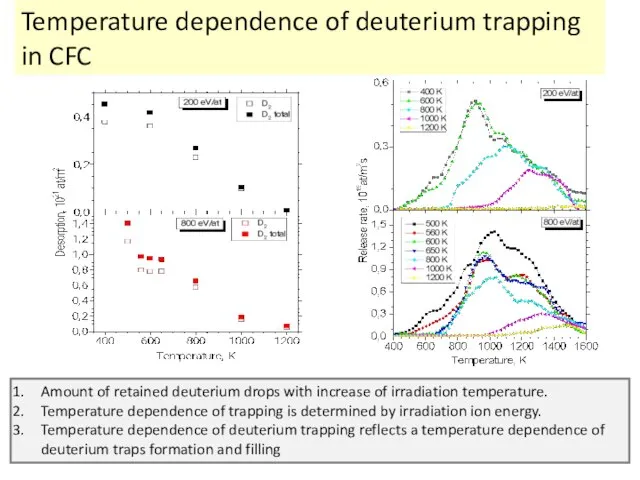
Temperature dependence of trapping is determined by irradiation ion energy.
Temperature dependence of deuterium trapping reflects a temperature dependence of deuterium traps formation and filling
Слайд 15Deuteromethane formation in CFC irradiated by deuterium ions and electrons
Thermal desorption of
Deuteromethane formation in CFC irradiated by deuterium ions and electrons
Thermal desorption of
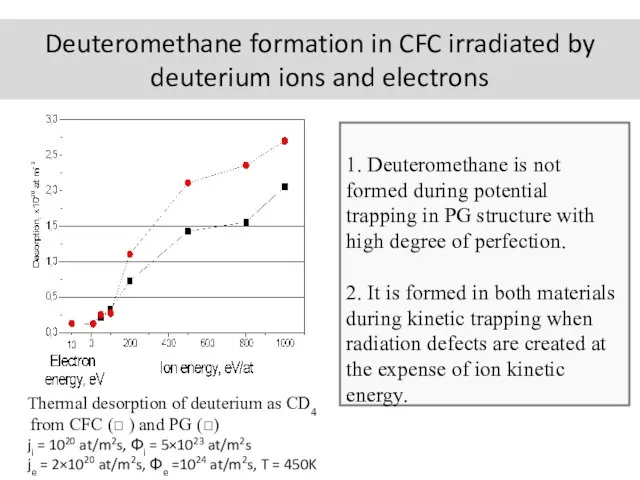
from CFC ( ) and PG ()
ji = 1020 at/m2s, Φi = 5×1023 at/m2s
je = 2×1020 at/m2s, Φe =1024 at/m2s, T = 450K
1. Deuteromethane is not formed during potential trapping in PG structure with high degree of perfection.
2. It is formed in both materials during kinetic trapping when radiation defects are created at the expense of ion kinetic energy.
Слайд 16TDS spectra of deuterium as D2 and CD4 from CFC irradiated by
TDS spectra of deuterium as D2 and CD4 from CFC irradiated by
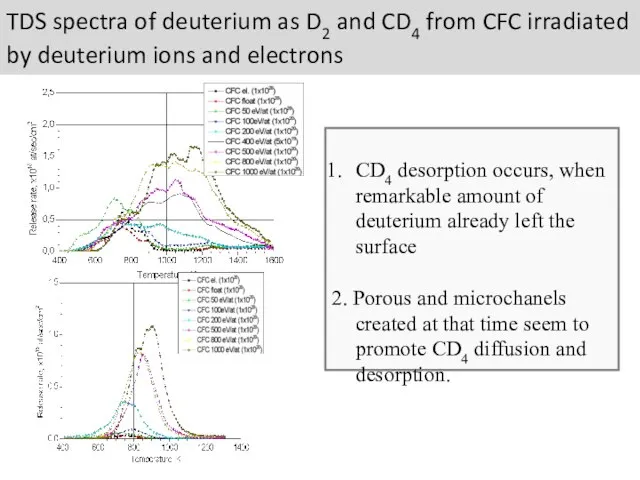
CD4 desorption occurs, when remarkable amount of deuterium already left the surface
2. Porous and microchanels created at that time seem to promote CD4 diffusion and desorption.
Слайд 17Deuterium trapping in CFC exposed in deuterium plasma with oxygen impurities
Deuterium and
Deuterium trapping in CFC exposed in deuterium plasma with oxygen impurities
Deuterium and

(ji(D+O) =1×1020 at/m2s, Φi(D+O) =5×1023 at/m2, Ei(D+O) =50 eV).
1. Oxygen activates “potential” mechanism of trapping and thus enhances deuterium trapping in CFC.
2. At the same time, presence of oxygen decreases concentration of deuterium in the sorbed layer on the surface leading to decrease of its trapping.
3. These controversial influences
explain appearance of maximum at dependency of deuterium trapping on oxygen concentration.
Слайд 18The hydrogen and oxygen trapping and retention in SS and nickel
The hydrogen and oxygen trapping and retention in SS and nickel

Слайд 19Modification of working gas composition during plasma discharge
Irradiation of the walls of
Modification of working gas composition during plasma discharge
Irradiation of the walls of
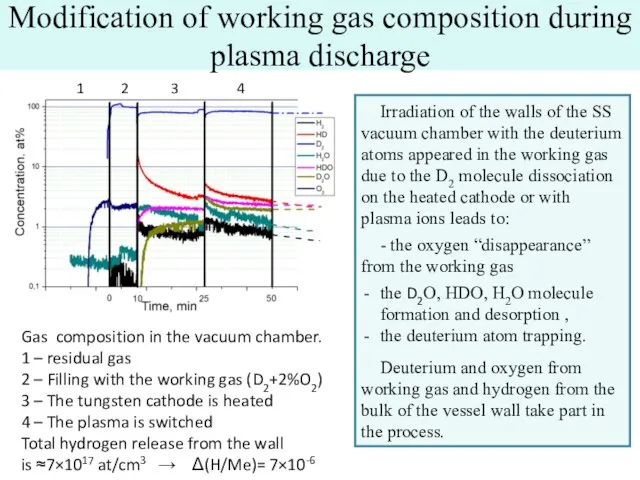
- the oxygen “disappearance” from the working gas
the D2O, HDO, H2O molecule formation and desorption ,
the deuterium atom trapping.
Deuterium and oxygen from working gas and hydrogen from the bulk of the vessel wall take part in the process.
Gas composition in the vacuum chamber.
1 – residual gas
2 – Filling with the working gas (D2+2%O2)
3 – The tungsten cathode is heated
4 – The plasma is switched
Total hydrogen release from the wall
is ≈7×1017 at/cm3 → Δ(H/Me)= 7×10-6
1
2
3
4
Слайд 20The possible D-atom/ion induced exothermic reactions on the SS surface resulting in
The possible D-atom/ion induced exothermic reactions on the SS surface resulting in
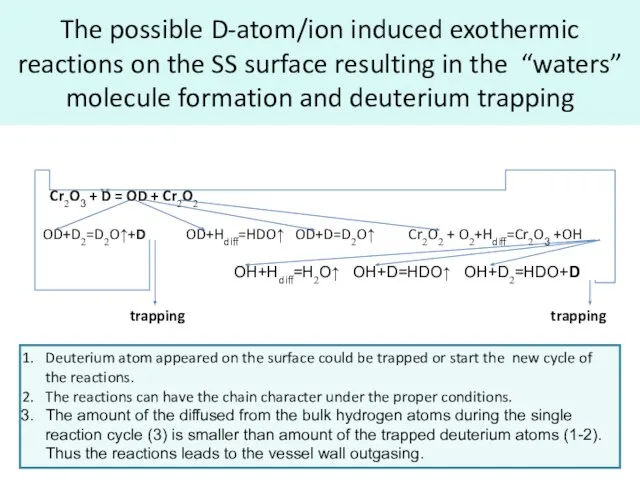
,,,,,
Cr2O3 + D = OD + Cr2O2
OD+D2=D2O↑+D OD+Hdiff=HDO↑ OD+D=D2O↑ Cr2O2 + O2+Hdiff=Cr2O3 +OH
OH+Hdiff=H2O↑ OH+D=HDO↑ OH+D2=HDO+D
trapping trapping
……
Deuterium atom appeared on the surface could be trapped or start the new cycle of the reactions.
The reactions can have the chain character under the proper conditions.
The amount of the diffused from the bulk hydrogen atoms during the single reaction cycle (3) is smaller than amount of the trapped deuterium atoms (1-2). Thus the reactions leads to the vessel wall outgasing.
Слайд 21The deuterium, hydrogen and oxygen trapping in the annealed SS
(Pw.g =
The deuterium, hydrogen and oxygen trapping in the annealed SS (Pw.g =
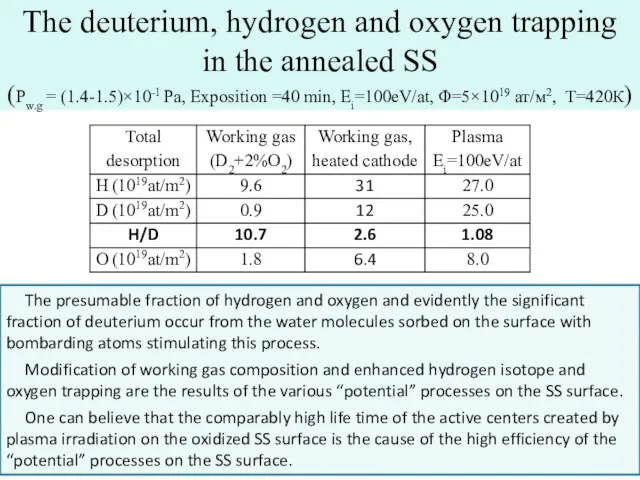
The presumable fraction of hydrogen and oxygen and evidently the significant fraction of deuterium occur from the water molecules sorbed on the surface with bombarding atoms stimulating this process.
Modification of working gas composition and enhanced hydrogen isotope and oxygen trapping are the results of the various “potential” processes on the SS surface.
One can believe that the comparably high life time of the active centers created by plasma irradiation on the oxidized SS surface is the cause of the high efficiency of the “potential” processes on the SS surface.
Слайд 22Energy dependence on deuterium trapping in SS and nickel irradiated by the
Energy dependence on deuterium trapping in SS and nickel irradiated by the
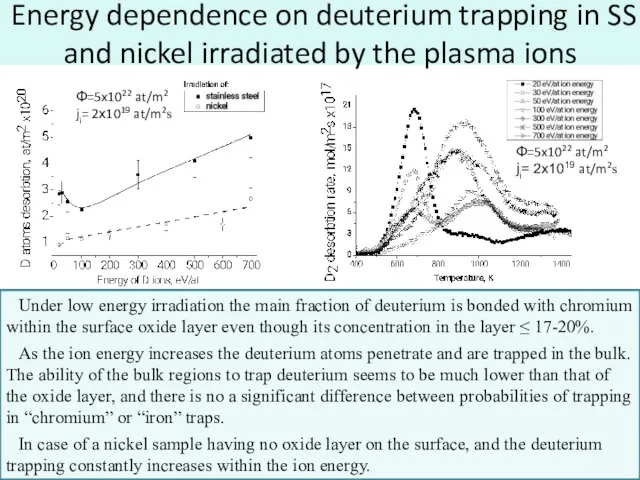
Under low energy irradiation the main fraction of deuterium is bonded with chromium within the surface oxide layer even though its concentration in the layer ≤ 17-20%.
As the ion energy increases the deuterium atoms penetrate and are trapped in the bulk. The ability of the bulk regions to trap deuterium seems to be much lower than that of the oxide layer, and there is no a significant difference between probabilities of trapping in “chromium” or “iron” traps.
In case of a nickel sample having no oxide layer on the surface, and the deuterium trapping constantly increases within the ion energy.
Φ=5x1022 at/m2
ji= 2х1019 at/m2s
Φ=5x1022 at/m2
ji= 2х1019 at/m2s
Слайд 23Fluence dependence on deuterium and oxygen trapping in SS and nickel
Irradiation dose,
Fluence dependence on deuterium and oxygen trapping in SS and nickel
Irradiation dose,
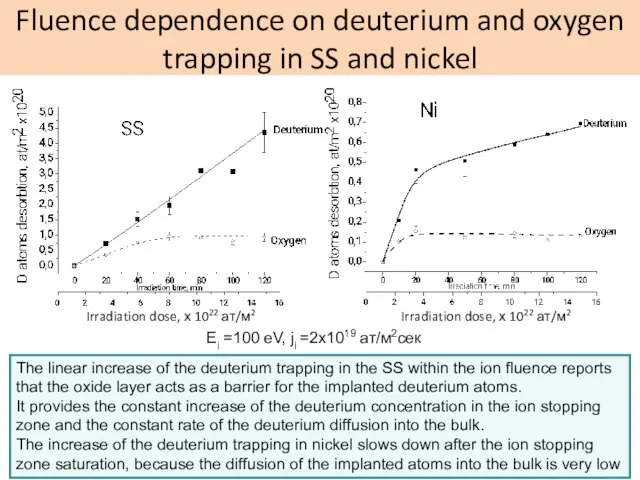
Ei =100 eV, ji =2х1019 ат/м2сек
Irradiation dose, х 1022 ат/м2
The linear increase of the deuterium trapping in the SS within the ion fluence reports that the oxide layer acts as a barrier for the implanted deuterium atoms.
It provides the constant increase of the deuterium concentration in the ion stopping zone and the constant rate of the deuterium diffusion into the bulk.
The increase of the deuterium trapping in nickel slows down after the ion stopping zone saturation, because the diffusion of the implanted atoms into the bulk is very low
Слайд 24Conclusion
Carbon materials.
CFC and PG trap deuterium even when the energy of impinging
Conclusion
Carbon materials.
CFC and PG trap deuterium even when the energy of impinging
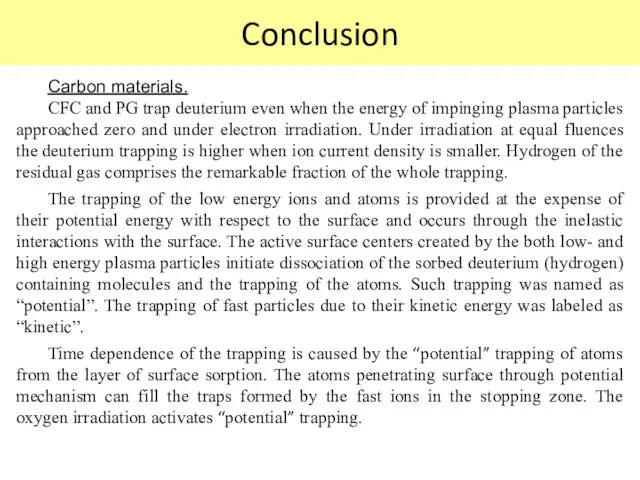
The trapping of the low energy ions and atoms is provided at the expense of their potential energy with respect to the surface and occurs through the inelastic interactions with the surface. The active surface centers created by the both low- and high energy plasma particles initiate dissociation of the sorbed deuterium (hydrogen) containing molecules and the trapping of the atoms. Such trapping was named as “potential”. The trapping of fast particles due to their kinetic energy was labeled as “kinetic”.
Time dependence of the trapping is caused by the “potential” trapping of atoms from the layer of surface sorption. The atoms penetrating surface through potential mechanism can fill the traps formed by the fast ions in the stopping zone. The oxygen irradiation activates “potential” trapping.
Слайд 25Conclusion
SS and Nickel.
Irradiation of the walls of the SS vessel with the
Conclusion
SS and Nickel.
Irradiation of the walls of the SS vessel with the

The low energy deuterium and hydrogen atoms trapped in the SS are mainly bonded with chromium inside the surface oxide layer. High energy particles penetrate into- and are trapped in the bulk.
The oxide layer hampers the release of the implanted deuterium from SS. It provides the constant increase of the deuterium concentration in the ion stopping zone and the constant rate of its diffusion into the bulk.
Modification of working gas composition and enhancement of the hydrogen isotope and oxygen trapping are the results of the various “potential” processes on the SS surface.
One can believe that the cause of the high efficiency of the “potential” processes on the destructed surface of carbon materials and on oxidized SS surface is the comparably high life time of the surface active centers created by plasma irradiation.
 Развитие психики и сознания
Развитие психики и сознания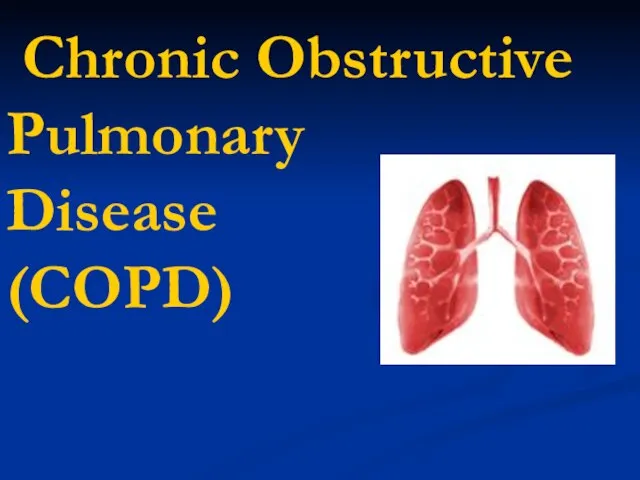 Chronic Obstructive Pulmonary Disease
Chronic Obstructive Pulmonary Disease  Ф. М. Достоевский «Преступление и наказание»
Ф. М. Достоевский «Преступление и наказание» Требования к знаниям и умениям
Требования к знаниям и умениям Транспортно-пересадочные узлы
Транспортно-пересадочные узлы Как ищем клиентов. Анализ дилера
Как ищем клиентов. Анализ дилера Художественный отдел
Художественный отдел Лексико – грамматические разряды фразеологизмов
Лексико – грамматические разряды фразеологизмов Презентация на тему Эволюция развития русской экономической мысли
Презентация на тему Эволюция развития русской экономической мысли ООО «Дневник.ру», Санкт-Петербург 2012. Статистика.
ООО «Дневник.ру», Санкт-Петербург 2012. Статистика. Презентация на тему ПЛАСТИЛИН
Презентация на тему ПЛАСТИЛИН  Критерии оценки персонала
Критерии оценки персонала Регулирование саморегулирования илисаморегулирование саморегулирования?
Регулирование саморегулирования илисаморегулирование саморегулирования? СВОЯ ИГРА v1
СВОЯ ИГРА v1 РРС Краснодар. Еженедельный отчет по направлениям в развитии
РРС Краснодар. Еженедельный отчет по направлениям в развитии Педагогическая практика
Педагогическая практика 1.Мероприятия 2.Сроки выполнения 3.Ответственный за выполнение
1.Мероприятия 2.Сроки выполнения 3.Ответственный за выполнение Биологическое действие радиоактивных излучений
Биологическое действие радиоактивных излучений Антонимы в современной русской речи
Антонимы в современной русской речи Молодежь как социальная группа. Девиантность в молодежной среде
Молодежь как социальная группа. Девиантность в молодежной среде Психологические проблемы обучаемости и школьной успеваемости
Психологические проблемы обучаемости и школьной успеваемости Я – Цуру, Бумажный журавлик счастья
Я – Цуру, Бумажный журавлик счастья Автоматизация закупок для предприятий и организаций в целях реализации Федерального закона №223-ФЗ
Автоматизация закупок для предприятий и организаций в целях реализации Федерального закона №223-ФЗ Презентация на тему Минеральное питание растений
Презентация на тему Минеральное питание растений Паразитарные заболевания кожи
Паразитарные заболевания кожи ОБЩИЙ ОБЗОР ПОСОБИЙ ИЗДАТЕЛЬСТВА ДЛЯ ДОШКОЛЬНИКОВ
ОБЩИЙ ОБЗОР ПОСОБИЙ ИЗДАТЕЛЬСТВА ДЛЯ ДОШКОЛЬНИКОВ Презентация 1 ОС МИАЦ (показатели) (1)
Презентация 1 ОС МИАЦ (показатели) (1) Поэтический листок
Поэтический листок